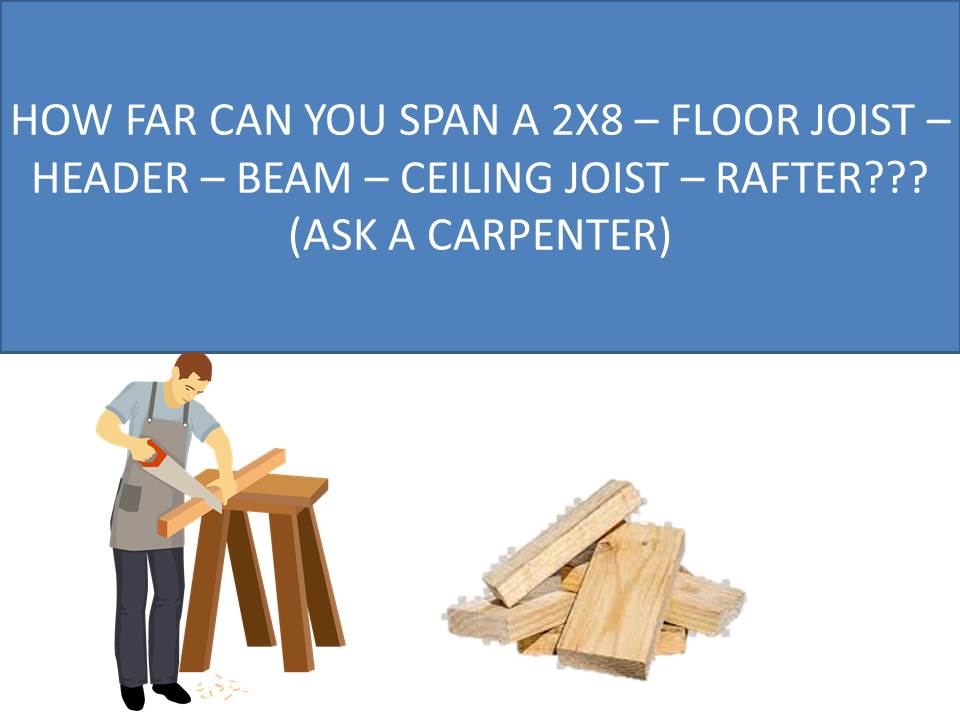Are you taking the plunge of some home remodeling project or are having some kind of extension; you might be interested to know the span for various structures of the framework including Ceiling Joist. So, if you’re wondering how far you can span a 2×8 Ceiling Joist; here’s a lead:
Ceiling Joist are the framework that supports the the ceiling and support and fix the diagonal rafter that define the roof shape. of your home. Knowing how far they can span is essential to making sure the the ceiling and support and fix the diagonal rafter that define the roof shape. is properly supported and safe for use.
In a 2×8 Ceiling Joist, the letter “8” is pretty important. It’s the depth of the Ceiling Joist. So, the span of 2×8 can be estimated by a rule of thumb i.e. 1.5 times the depth. So, a 2×8 Ceiling Joist can span a length of 1.5 x 8 equal 12 feet. But in reality, this span can vary between 10’ to 21’ 7” For an uninhibited area with limited storage and it can go upto 14’ 2” to more than 26’ for an inhabited area without storage need. .
Span is the maximum distance between two support points that a Ceiling Joist can stand without buckling or breaking. There are many factors to consider when determining the span of a Ceiling Joist, including the species of wood, the grade of lumber, the purpose of use, and the load it will bear.
In this blog post, we’ll discuss what factors to consider when determining the span of a 2×8 Ceiling Joist and how to calculate the length of the Ceiling Joist. We’ll also discuss different types of arrangements for Ceiling Joist, including single, double, and laminated veneer lumber (LVL). With this knowledge, you’ll be able to make sure your the ceiling and support and fix the diagonal rafter that define the roof shape. are properly supported and safe for use.
Let’s first start by discussing basics of a span in general:

What is a Ceiling Joist?
Ceiling Joists are the horizontal members that provide a structure to fix the ceiling, and support and fix the diagonal rafters that define the roof shape and are attached at the top to a ridge beam. Ceiling joists are the horizontal structural members th
What is a span?
Span is the measurement of the linear distance a beam, board, rafter, or joist can stand without additional support and without bending or failure. Span is a critical factor when considering how to design and construct the frame a house or building. For Ceiling Joist, span is affected by several factors, including the size and species of wood, grade of lumber, purpose of use, and load applied to it.
Since, there’re a lot of factors affecting span, International Residential Building Code (IRC), in it’s 2018 edition has specified maximum or allowable span for all elements like joists, beams, headers, and rafters.
Like Us on Facebook!
Understanding the span of a beam is an important factor in determining the strength of a structure. It’s also an important consideration when determining the right type of lumber or beam to use in a construction project or a building.
Subscribe Us on YouTube!
The most common types of Ceiling Joist used in residential construction are single, double joists, and laminated veneer lumber (LVL).
- How far can you span a 2×8 rafter
- How far can you span a 2×8 floor joist
- How far can you span a 2×8 header
Each type of beam has different span requirements based on the weight and purpose of use. For example, a single Ceiling Joist can typically span up to less, while a double Ceiling Joist can typically span more. LVL beams have a higher capacity for span, but the span will vary depending on the weight and purpose of use.
Factors affecting span of a 2×8 Ceiling Joist
When determining the span of a Ceiling Joist, there are several factors to consider.
- The species of wood used for the Ceiling Joist can affect the span length; usually, engineered wood products such as laminated veneer lumber (LVL) and glulam (glued laminated timber) are more resistant to warping and shrinking than other species of wood.
- The depth of the structural element also affects span length; deeper elements are capable of supporting heavier loads over longer distances.
- The grade of the lumber being used for Ceiling Joist is also important; higher grades have fewer knots, which may affect the strength of the beam.
- Additionally, spacing between Ceiling Joist affects span length; greater spacing between joists will result in a longer span for the beam.
- The purpose for which the beam is being used also plays a role; for example, floor joists must be able to support the weight of a room’s contents, whereas ceiling joists do not need to bear as much load.
- Finally, the load that the beam must support is a critical factor; heavier loads require beams with greater strength and thus shorter spans.
How far can you span a 2×8 Ceiling Joist?
For a douglas fir with spacing in center of 12”, the Ceiling Joist can span 26’ at 12” spacing but for spacing at 24”; the maximum allowed span is 20’-1” at 24” spacing. For southern pine with spacing of 12” you can span the Ceiling Joist to 18’-2” while with spacing of 24”, the maximum allowed span is 13’-6”. With rederwood or cedars, the spacing for Ceiling Joist varies between 11’-8” to 8’-8” (with spacing of 24” and reduced to 12”).
Conclusion
So, you see be it a floor joist, deck joist, or rafter; the maximum span allowed varies by the spacing in between the Ceiling Joist and wood specie you choose. So, it’s best that you have a clear understanding of allowable span limits to build a sturdy structure. Try to select the specie of make first and then consider other factors including load, grade, and spacing of the floor joists to determine how far can you span a 2×4 Ceiling Joist without additional support.
Also Read:

















